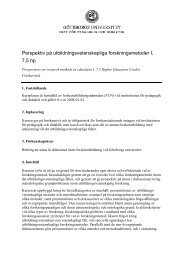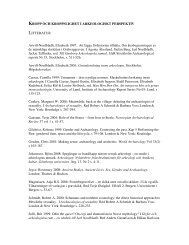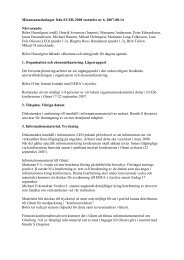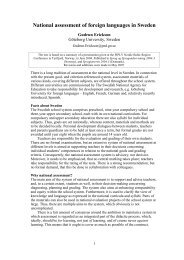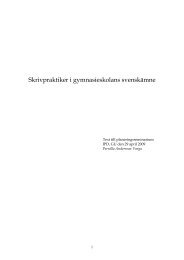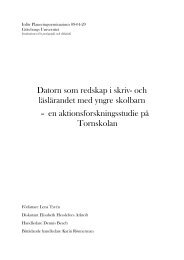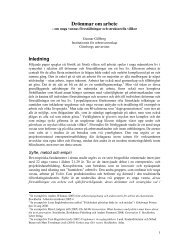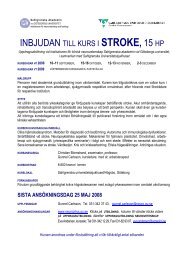flerspråkighet i förskolan - Institutionen för pedagogik och didaktik ...
flerspråkighet i förskolan - Institutionen för pedagogik och didaktik ...
flerspråkighet i förskolan - Institutionen för pedagogik och didaktik ...
Create successful ePaper yourself
Turn your PDF publications into a flip-book with our unique Google optimized e-Paper software.
Findings and discussion<br />
Four result chapters are structured around the preschool activities in which interactions<br />
between children occurred. The findings of these chapters are summarised below.<br />
The variety of communicative actions and topics of communications in meetings of children<br />
was evident in their. Only Swedish is used. The communications occur in the interactions in<br />
activities within play situations. There is mutuality in the interactions according to individual<br />
children’s level of communicative skills and the communicative skills of the group.<br />
The use of both languages by children with the same first language depended on the nature of<br />
the preschool activities. Mealtime was a site for practice in which Swedish was spoken while<br />
code-switching was used in other play situations. The context, situation and individuals<br />
involved had an impact on the language usage.<br />
Within participation in interaction over time between peers with different languages, then<br />
there needed to be flexibility in opportunities to communicate. Flexibility refers to the social<br />
and verbal aspects of communication in being able to “change” topics and through the<br />
variation of playmates.<br />
Children with different first languages extended their collaborative play through scaffolding<br />
by other children. The children maintained their play that at the same time offered them<br />
opportunity to learn verbal and social skills. Engagement, perspective-taking and<br />
collaboration characterised the communications. Continuous maintenance of play characters<br />
within activities seems essential to extend the play. When children had experience of the play<br />
themes and roles, the possibility of repeating each other’s actions was possible when there<br />
was time and room for play, and toys and supportive teachers were available.<br />
Multilingualism in preschools – initiative, relationship between children and<br />
opportunity for interaction<br />
The integrated focus of analysis - individual, interactional and institutional, on<br />
communication creates knowledge about multilingual children’s communicative strategies,<br />
collaboration and social practices in context. Swedish is used by the children as a common<br />
language in the preschools. In that context, children seem to use the languages functionally<br />
from a very early age. However, they can switch languages to use their first language with





